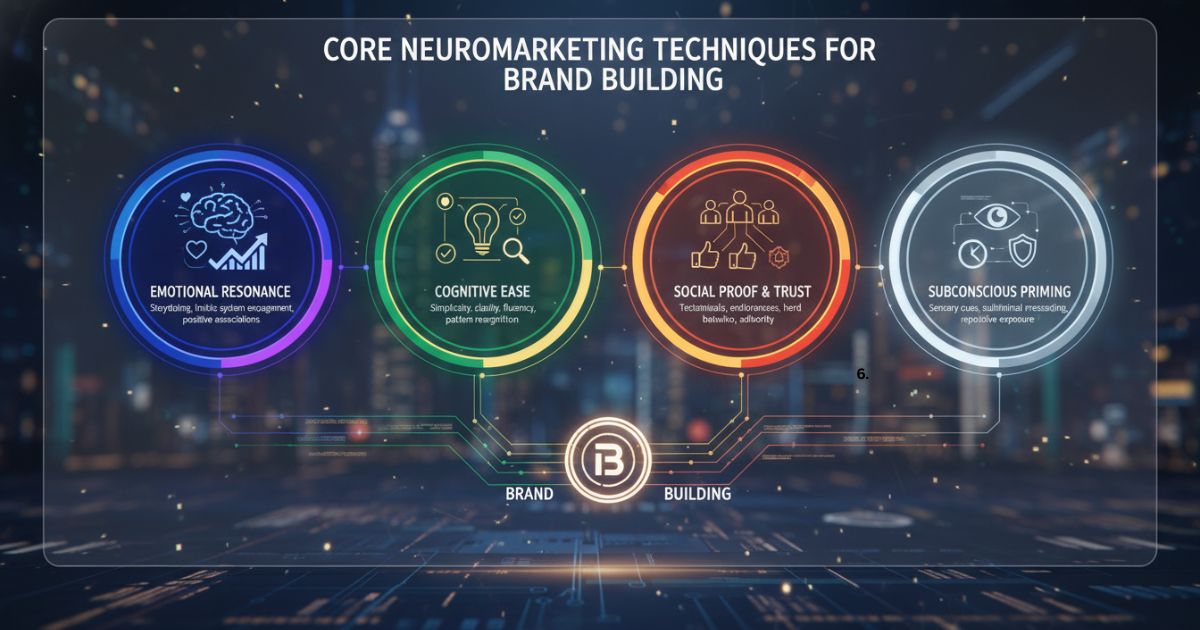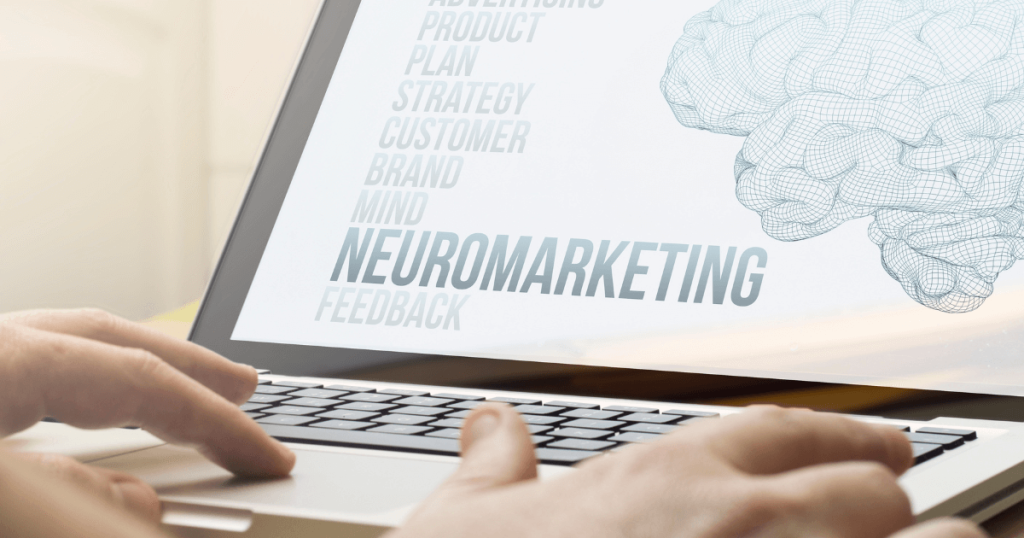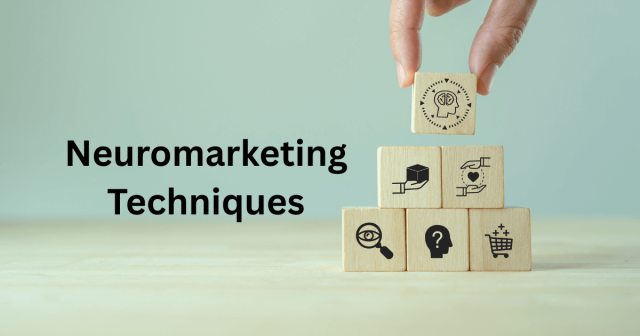Building a strong brand takes more than a catchy slogan or a polished logo. The most successful brands connect with people at a deeper level—inside the subconscious mind, where most buying decisions actually happen. This is where neuromarketing plays a powerful role.
Neuromarketing combines neuroscience, consumer psychology, and marketing science to understand how the human brain responds to brands, ads, colors, sounds, and stories. Instead of relying only on surveys or focus groups, neuromarketing uses data-driven methods to reveal real emotional and neurological reactions. This helps brands understand what consumers truly feel, not just what they say.
By studying brain activity, attention patterns, and emotional responses, neuromarketing uncovers how brand perception, trust, and memory are formed. These insights help businesses design marketing strategies that feel more natural, engaging, and persuasive. Brands can improve brand recall, strengthen emotional connection, and influence purchase decisions more effectively.
This guide explores proven neuromarketing techniques such as eye tracking, color psychology, sensory branding, and emotional storytelling. Whether you are launching a new product, improving brand positioning, or optimizing customer experience, these evidence-based strategies will help you create more meaningful and memorable brand experiences that drive long-term growth.
What is Neuromarketing and Consumer Psychology?

Neuromarketing combines neuroscience, consumer psychology, and marketing to understand how the human brain responds to brands, ads, and messaging. This field—often called consumer neuroscience—studies unconscious reactions that influence buying behavior, not just what people say in surveys or interviews.
The human brain makes decisions using both emotional and rational processes. Traditional marketing focuses mainly on logic, such as features and pricing. Neuromarketing shows a different truth: emotions drive up to 95% of purchasing decisions. This insight helps brands create messages that feel more natural and persuasive.
By understanding how people think and feel, brands can design marketing that connects on a deeper level. This includes improving brand perception, building trust, and strengthening emotional connection with customers.
Brain imaging studies reveal that strong brands activate neural networks linked to pleasure, trust, and personal identity. When people see brands they love, the brain reacts in a similar way to seeing close friends or family. This explains why some brands enjoy strong brand loyalty, while others struggle to stay memorable.
One of the most practical neuromarketing tools is eye tracking technology. Eye tracking shows where users look, how long they focus, and what grabs their attention first. These insights help brands optimize website design, advertising layouts, and product packaging so messages are easier to notice and remember.
By applying neuromarketing principles, brands can better understand consumer behavior and create experiences that truly resonate with the human mind.
Core Neuromarketing Techniques for Brand Building

Color Psychology and Brand Perception
Colors trigger immediate emotional responses before conscious thought occurs. This is the foundation of color psychology, which explains how different colors influence human emotions, behavior, and decision-making. Research in consumer neuroscience shows that the right color choices can increase brand recognition by up to 80%. Different hues activate distinct neural pathways, shaping how consumers perceive your brand’s personality and core values.
Red creates feelings of urgency, energy, and excitement, which is why it works well for clearance sales, fast-food brands, and call-to-action buttons. Blue communicates trust, stability, and reliability, making it a popular choice for financial institutions, technology companies, and healthcare brands. Green is associated with growth, nature, and sustainability, while purple is often linked to luxury, creativity, and premium experiences.
Strategic color application goes far beyond logo design. It should be consistent across your entire brand ecosystem, including websites, mobile apps, packaging, advertising, and social media visuals. When brands use color intentionally and consistently, they strengthen neural associations in the brain. This makes the brand easier to recognize, more memorable, and more competitive in crowded digital marketplaces.
Storytelling and Neurological Engagement
The human brain is wired for narrative. When consumers encounter compelling brand stories, multiple brain regions activate simultaneously, creating rich, memorable experiences. This neurological response to storytelling makes it one of the most powerful neuromarketing techniques available.
Effective brand narratives trigger mirror neurons, causing consumers to mentally simulate the experiences described in your stories. This neurological mirroring creates emotional connections that transcend rational evaluation, leading to stronger brand loyalty and advocacy.
Successful brand stories often follow archetypal patterns that resonate across cultures and demographics. The hero’s journey, transformation narratives, and origin stories tap into universal psychological frameworks that the brain recognizes and embraces instinctively.
Social Proof and Neural Validation
Consumer behaviour heavily relies on social validation. The brain’s reward systems activate when we see others engaging with brands, creating powerful motivational responses. This neurological tendency makes social proof one of the most effective neuromarketing strategies for building brand credibility.
Reviews, testimonials, and user-generated content provide the social validation that modern consumers’ brains crave. When potential customers see others enjoying positive experiences with your brand, mirror neurons fire, creating vicarious satisfaction that influences purchasing decisions.
Influencer partnerships and celebrity endorsements work by activating admiration pathways in the brain. When consumers see respected figures using your products, it triggers aspirational responses that strengthen brand desirability and perceived status.
Advanced Neuromarketing Applications
Measuring Neuromarketing Effectiveness
Eye Tracking and Attention Analysis
Eye tracking is one of the most widely used neuromarketing tools. It shows where people look, what they notice first, and how long their attention stays on specific brand elements. Unlike surveys, eye tracking captures real behavior, not opinions, making the data more accurate and reliable.
Eye tracking heat maps visually display attention patterns. They reveal which parts of a website, ad, or product packaging attract focus and which areas are ignored. This insight helps brands optimize website layout, UX design, ad creatives, and product placement for better engagement.
Pupil dilation is another key metric. When pupils expand, it signals higher emotional arousal or mental effort. This often indicates interest, curiosity, or strong engagement. Smaller or static pupils may suggest confusion, boredom, or discomfort. These signals help marketers understand emotional impact at a subconscious level.
Biometric Response Monitoring
Biometric tracking measures physical reactions to brand stimuli in real time. Common methods include heart rate variability, skin conductance, and facial expression analysis. These metrics reveal emotional responses that consumers may not consciously recognize or verbally express.
Galvanic skin response (GSR) increases when emotional intensity rises. Higher readings often indicate excitement, stress, or emotional connection. In neuromarketing studies, strong GSR responses are linked to better brand recall, stronger memory encoding, and more positive brand perception.
Facial coding technology analyzes micro-expressions—tiny, involuntary facial movements that occur before conscious awareness. These expressions reveal genuine emotions such as joy, surprise, confusion, or frustration. By studying these reactions, brands can identify which visuals, messages, or storytelling elements trigger positive or negative responses.
Together, eye tracking and biometric monitoring give brands a clear, data-driven view of attention, emotion, and engagement—helping marketers refine campaigns and create more effective, emotionally resonant brand experiences.
Implementing Neuromarketing in Your Brand Strategy

Practical Application Framework
Start with simple neuromarketing techniques that provide immediate insights without significant investment. A/B testing different color schemes, headlines, or images can reveal preference patterns that guide broader brand strategy decisions.
Develop brand guidelines that incorporate neuromarketing principles across all touchpoints. Consistency in sensory elements, emotional triggers, and cognitive patterns strengthens neural associations and improves brand recognition.
Train your marketing team to understand basic consumer neuroscience principles. This knowledge helps them create more effective campaigns and recognize opportunities to apply neuromarketing techniques throughout the customer journey.
Integration with Traditional Marketing
Neuromarketing works best when it supports, not replaces, traditional marketing research. By combining neurological insights with demographic data, psychographic segmentation, and market analysis, brands gain a deeper understanding of how and why consumers make decisions. This integrated approach connects what people say with how their brains actually respond.
Brands can use neuromarketing data to validate and refine existing marketing strategies. For example, if focus groups respond positively to one message but brain imaging, eye-tracking data, or emotional response metrics show stronger activation for another, the gap reveals valuable insights into subconscious consumer behavior. This helps marketers improve messaging, positioning, and creative direction.
Continuous testing is essential. Consumer preferences change, and market dynamics evolve. Ongoing A/B testing, biometric feedback analysis, and attention tracking ensure neuromarketing strategies remain effective over time. Regular measurement of neural and emotional responses helps brands identify when campaigns, visuals, or brand messages need updating.
When traditional marketing research and neuromarketing work together, brands create more accurate insights, stronger emotional connections, and smarter, data-driven marketing decisions.
Building Stronger Brands Through Neuroscience
Neuromarketing techniques give brands a powerful way to build deeper connections and support long-term business growth. By understanding how the human brain processes brand messages, marketers can design experiences that connect on both conscious and subconscious levels. This approach goes beyond traditional marketing by focusing on emotions, memory, and attention.
Modern brands are increasingly using consumer neuroscience, behavioral psychology, and brain-based marketing to improve brand perception. Techniques such as eye tracking, emotional response analysis, and sensory branding help businesses understand what truly captures attention and drives decision-making. These insights allow brands to create content that feels more relevant, trustworthy, and memorable.
The future of marketing belongs to brands that understand how people think, feel, and decide—not just who they are demographically. Companies like Google, Apple, Coca-Cola, and Nike already apply neuroscience-driven strategies to strengthen emotional branding and customer loyalty. When brands align with how the brain naturally works, they improve brand recall, emotional engagement, and purchase intent.
Success with neuromarketing requires a thoughtful and systematic approach. Start small by applying one or two proven neuromarketing methods, such as simplifying visual design or using emotionally driven storytelling. Measure results using data and feedback. Over time, expand your neuromarketing toolkit as your confidence and understanding grow.
By combining neuroscience insights with traditional marketing strategy, brands can create meaningful experiences, build trust, and gain a sustainable competitive advantage in today’s crowded digital marketplace.
FAQs
1. What is neuromarketing in simple terms?
Neuromarketing is the use of neuroscience and psychology to understand how people’s brains respond to marketing. It helps brands learn what customers feel, notice, and remember—often without them realizing it.
2. How does neuromarketing influence consumer behavior?
Neuromarketing influences consumer behavior by targeting emotional and subconscious decision-making. It uses insights like attention, emotion, and memory to shape how people perceive brands and make buying decisions.
3. What are the most common neuromarketing techniques used by brands?
Common neuromarketing techniques include eye tracking, color psychology, sensory branding, storytelling, social proof, and biometric measurements such as facial expressions and skin response.
4. Is neuromarketing ethical to use in marketing?
Yes, neuromarketing is ethical when used responsibly. It focuses on understanding consumer needs and improving user experience, not manipulating or deceiving customers. Transparency and data privacy are essential.
5. Can small businesses use neuromarketing strategies?
Absolutely. Small businesses can apply simple neuromarketing strategies like improving visual hierarchy, using emotional storytelling, optimizing colors, and reducing cognitive load—without expensive technology.
6. How does neuromarketing improve brand perception and loyalty?
Neuromarketing improves brand perception by creating emotional connections that the brain remembers. When brands trigger positive feelings like trust, pleasure, or belonging, customers are more likely to stay loyal and advocate for the brand.




